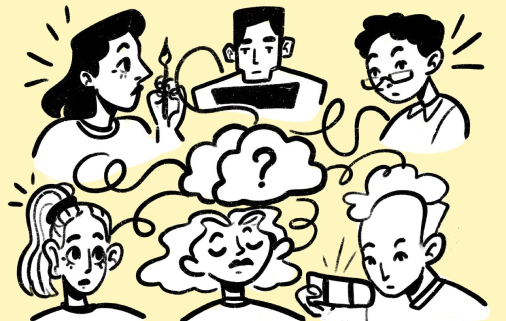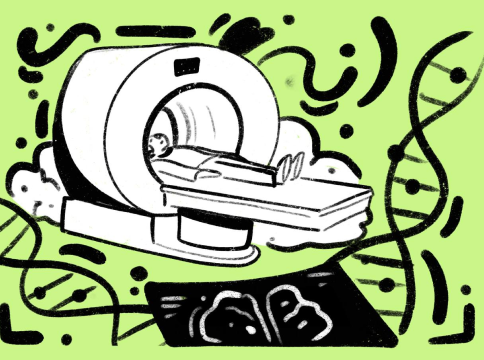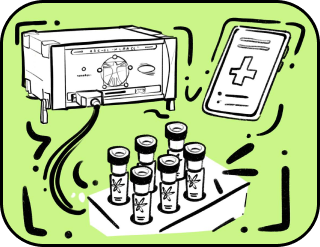How to identify a genius: scientific and practical insights
“People are not equal in terms of intellect or willpower. The fairy of genius does not bless everyone on the forehead. Judging by the statistics, she’s practically a sociopath, avoiding people altogether.”
Franz Wertvollen
Geniuses walk among us, watch the same shows we do, breathe the same air we do. To say more, they even wear the same clothes as us. But most often, we don’t even realize we’ve had the experience of interacting with a genius. And even geniuses themselves may not always be aware of their exceptional nature or may simply choose not to display it. This raises a serious and important question: how, then, in case of urgent need, can we identify geniuses among the multitude of ordinary, average people? How can we know that the person in front of us was that rare one born once in a century?
Is it possible that if we look closely, we might notice certain characteristics that reveal a genius? Or have modern technologies already found a way to study the human brain to provide complete information about each person’s personality and intellectual abilities?
The answer to each of these questions could be a solution, but each contains nuances worth pondering. And perhaps there is a third, unique solution — the one that, in theory, may one day allow us to save the world and the future of humanity in a difficult and, at first glance, unsolvable situation.
In other words, in our quest to identify geniuses among the masses, we should pay attention to both internal and external characteristics, as well as use the achievements of science and technology. This could be the key to uncovering hidden talents and abilities that might transform our world for the better, making the process of interacting with a potential genius even more exciting. After all, each of us can become part of this amazing journey if we are ready to open new horizons and expand our ideas of what it means to be a genius.
How often have your family, friends, or close ones called you a “genius” when you said or did something others couldn’t think of? Certainly, receiving such a title is always pleasant; after all, being a genius is almost like being a superhero, but instead of a cape, you have a brain running at maximum capacity. But is there a difference between true genius and the clever moments each of us has had at least once in our lives, impressing those around us with our unconventional thinking?
From a psychological perspective, genius is the highest level of intellectual and creative ability, resulting in works of art or scientific and technical achievements that are celebrated long after the genius has left this world. In other words, a genius is a creator who lives not just for themselves but for the benefit of society. They have a mission: instead of saving the world, they might invent something groundbreaking. Not bad at all.
Although scientists have not found exact signs that distinguish geniuses from ordinary people, there are some “markers” of genius by which we can try to recognize them. For instance:
- Skull Structure. If the head is large, it could mean there are plenty of ideas inside. If someone looks like they have a whole library in their head, take a closer look and try asking them a brilliant question.
- Forehead Size. If the forehead is so large you could draw a world map on it, this person is likely a fast learner who solves problems as easily as playing a preschool-level video game.
- Face Shape. A heart-shaped face suggests a “creative genius,” while a square-shaped face suggests a “logical thinker.” If you see someone with a square face, they might be a programmer, mathematician, or a genius in exact sciences.
- Nose Shape. A straight nose earns an instant ticket to the world of art, while wide nostrils may suggest a higher-than-average intellect. If you see someone with a nose like Rembrandt’s, they might be on the path to creating a masterpiece.
- Ear Symmetry. Geniuses often have asymmetrical ears, as if they were designed by two different makeup artists for a movie. A potential genius might have one ear larger than the other, and that’s perfectly normal.
- Eye Color. Light-colored eyes — blue, green, or gray — might hint at high intelligence. If your conversation partner looks at you with gray or green eyes, they might be envisioning a brilliant new idea they’ll soon bring to life.
- Marfan Syndrome. This syndrome is characterized by unnaturally tall height, extreme slenderness, and long, spidery fingers. Despite their frail appearance, people with Marfan syndrome often have an abundance of adrenaline, allowing them to think faster than you can say “genius”.
- Mood Swings. Surprisingly, frequent mood swings can stimulate brain activity. So, if someone is showing what seems like another mood swing, they might just be demonstrating genius in action.
Beyond all that, geniuses are unique individuals who often excel in something incredible but may be complete “novices” in other areas. For example, they might create a masterpiece in art or invent something brilliant, yet be unable to properly tie their shoelaces or start a conversation with a neighbour. Their social skills are often at the level of, “Hi, I’m a genius, and who are you?”
From childhood, these individuals possess creative thinking that simply cannot be hidden under the bed or go unnoticed. They can solve problems as if they have a little math gnome living in their heads, whispering solutions to them. For example, instead of simply adding two plus two, they might conclude it’s better to build a time machine and travel back to find the answer there.
Geniuses are usually focused on one thing — whether it’s science or art. They could be mathematicians or poets, but in school, they’re likely to get low grades in physical education because P.E. just isn’t their forte. Einstein, for instance, struggled with many school subjects, but that didn’t stop him. Teachers usually don’t understand that geniuses aren’t interested in spending time on boring subjects, and it’s best to give them complete freedom to pursue what genuinely interests them.
Persistence is the superpower of geniuses. They can stubbornly pursue their goals even if everyone around them thinks they’ve lost their minds. They have no weak points in character, only determination and talent, which combine into a powerful force.
Geniuses often know why they are here, and this certainty doesn’t resemble pride. It’s more like an internal GPS that always points them in the right direction. Their ideas might be so innovative that they aren’t understood until they become classics. For example, Nikola Tesla was a true prophet of his time, but his ideas gained popularity only many years later.
Geniuses aren’t afraid to take risks because they are confident in their actions. Thomas Edison, for example, tried hundreds of methods to illuminate a room before inventing the light bulb. Geniuses also tend to follow the call of their inner voice, which guides them on their path. It can even seem as if they have an invisible friend constantly saying, “Hey, try this!” and they listen. Sometimes, geniuses even solve complex problems in their sleep, like Mendeleev did.
Geniuses are people with an unusual perspective on the world, who see things hidden from others, and they need just a bit of persistence to bring their ideas to life. If they can’t express their thoughts, they feel like fish out of water.
Thus, by possessing keen observational skills and an ability to notice details, each of us can identify a genius in a large crowd based on external and characteristic signs offered by everyday experience. However, the nuance here is that this analysis can’t be 100% accurate, and the likelihood of mistaking a regular person for a genius or vice versa is never zero. This means that with such an approach, the chances of a brilliant plan to save the world from some catastrophe significantly decrease.

Developing technologies may also help us recognize a genius in a crowd. For example, in 2018, researchers learned how to identify geniuses using special brain scans. To be precise, this brain scanning helps determine whether a person has creative thinking (creative skills) or not. Researchers have found a “pattern” of neural activity that can highlight people who excel at generating original ideas, like Steve Jobs or Elon Musk.
An international team of scientists, led by geniuses from Harvard, discovered three regions of the brain responsible for creative thinking. They found that, in creative people, the connections between these brain areas work like a well-oiled machine, whereas in less creative people, it’s more like rusty old gears.
Scientists scanned the brains of 163 people, including artists, musicians, and scientists. For this, they used functional MRI, which essentially shows where a “blood disco” happens in the brain during creative tasks.
During the scan, participants were given 12 seconds to come up with an original use for an object that appeared on the screen. For example, if a knife appeared on the screen, one participant might say it’s a “cutting tool,” while another, with a more developed imagination, might suggest it’s “the first step to creating a culinary masterpiece” or that the tip of the knife could be used to create truly unusual paintings.
Three independent experts rated the responses, and these ratings were then compared to the MRI data. It turned out that when participants completed a creative task, three different neural networks in their brains worked in harmony like a synchronized orchestra. The better they synchronized, the more creative the ideas were. The first network was linked to the “default mode,” responsible for spontaneous thinking; the second, for control and evaluation; and the third, for “significance detection.” This last network helps a genius identify which ideas are truly important.
In the future, scientists plan to use this knowledge to enhance original thinking. So, if you suddenly find yourself thinking more creatively, don’t be surprised — it could just be “magnetic magic.”
In addition to studying the human brain, genetic scientists worldwide are investigating various genes in each person and studying how genes can influence human behavior. We often hear or read about the discovery of “genius genes,” “happiness genes,” “patriotism genes,” and “alcoholism genes.” Most of these claims lack any scientific basis and are simply a way to attract readers with a sensational headline.
But what if we assume that the “genius gene” isn’t fiction, but reality? For example, in a press release for a 2014 article in the journal Molecular Psychiatry, scientists claimed they had found a gene responsible for the density and thickness of gray matter in the cerebral cortex. This, according to previous studies, subtly hints at a person’s intelligence level.
Gray matter, known as the “neuron club,” is where the bodies of nerve cells and their “wiring” gather without a special lipid insulation. White matter, on the other hand, consists of branches that are covered with this insulation. The lipid insulation, or myelin, serves as true protection rather than a “useless shell.” Additionally, this insulation helps transmit brain signals faster, as if you were using high-speed internet instead of an old modem.
As for the mysterious “genius gene” known as NPTN, this gene is quite the expert when it comes to assembling proteins from tiny “bricks” — amino acids — that neurons need to communicate with each other. In this context, the protein acts as a crucial component of neurons’ “telephone system,” helping them “talk” to one another. Long extensions called axons serve as the “long-distance wires,” while short ones called dendrites handle “local calls.”
But brain chatterboxes also have “wireless communication.” Neurons can release chemicals called neurotransmitters into the “air” and communicate not just through synapses, but essentially by spreading signals through diffusion. Our brain, it seems, is a true telecommunications network, and the amount of “gray matter” it contains appears to correlate with how smart or genius-level a person is.
While it’s widely known that heredity affects the thickness and density of the cerebral cortex (strangely linked to intelligence), scientists struggled for a long time to find the specific gene responsible. To uncover it, they conducted a “genetic quest” with 1,583 healthy 14-year-olds. In addition to standard medical exams, these teenagers took IQ tests to assess their intelligence and completed tasks to measure vocabulary and pattern-matching skills. Their brains were also scanned via MRI to examine the appearance of their gray matter across 33 different areas of the cortex.
After this, researchers identified genes that behave differently at various stages of nerve cell development. That’s when they found the “star” — a single-nucleotide polymorphism, rs7171755, whose name resembles a message your friend’s cat might send if it walked across a keyboard. In essence, this code is a small DNA error that reduces the activity of the NPTN gene. This gene is responsible for a glycoprotein that helps nerve cells “talk” to each other. It turned out that teens with this mutation had a cortex 0.0189 mm thinner — not much, but it’s something!
Moreover, scientists discovered that NPTN gene activity, especially in childhood and adolescence, influences many other genes — 721, to be precise. Among these, 36 are linked to energy production, 27 to signal transmission, and 14 to memory and learning. Scientists concluded that such a mutation hinders cell “communication,” and unfortunately, this impacts cognitive abilities. They found a connection between the teens’ intelligence levels, gray matter density in the cortex, and NPTN gene activity, but it wasn’t strong enough to label NPTN as a “genius gene” or something similar. It appears that genius is not solely about genes.
Dr. Sylvane Desrivières, tired of the questions, stated one day that her team hadn’t found a “genius gene,” despite the news suggesting otherwise. The influence of this gene on cognitive ability is very small and doesn’t exceed the influence of numerous other factors. Unfortunately, the press tends to overlook this, preferring to focus on louder headlines. Instead, they popularized the idea that researchers “wanted to understand how differences in brain structure affect intellectual abilities.”
If we call the “genius gene” one without which genius is impossible (something that hasn’t been proven with NPTN), we would have to name many other genes the same way, like Pax6, without which the human brain wouldn’t form at all, and thus, there would be no genius.
Clearly, a single gene cannot determine a whole set of psychological characteristics. For instance, genealogical maps of Strauss, Mozart, Beethoven, Pushkin, and Dumas, created by psychogeneticists, confirmed a simple fact — geniuses have some tendency to inherit specific traits. For example, to compose music (specifically composing, not just reading notes, which anyone can be taught), one needs to inherit at least four pairs of “composer” genes. To be a good poet, one must inherit 10 pairs of recessive (inactive in the parents) genes.
Statistics show that far more geniuses are born than we realize. To allow a person’s innate genius abilities to manifest, a “hard work” gene is essential; without it, any person would grow up to be a promising mediocrity.
Returning to the condition of our task, we can confidently state that further research into the human brain using modern technologies and the work of genetic scientists could make a significant contribution to identifying and recognizing geniuses among ordinary people in order to utilize their unique abilities. However, the nuance in this solution is that such research may take a very long time, and in cases where it is urgently necessary to find geniuses in a crowd, we will have to rely solely on intuition and external traits.
And as we know, this offers absolutely no guarantees.

Scientists have decoded the human genome. We’ve decoded the genome of interest. Only pure science and facts.
Thank you!




